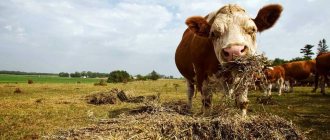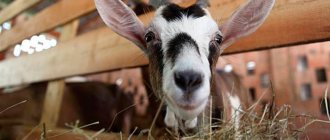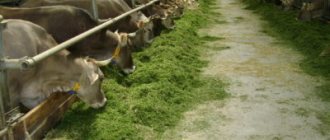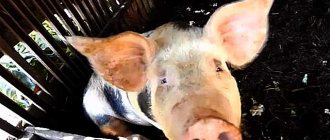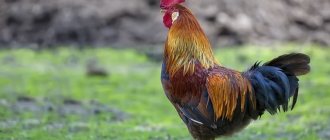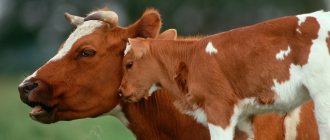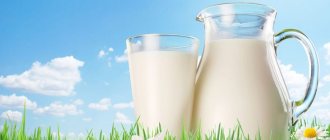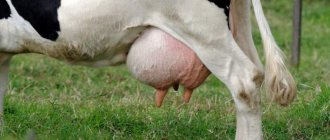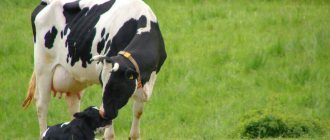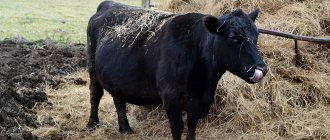April 12, 2015 1 Comment views
Only those cows that eat a lot give a lot of milk. It is the rate of feed consumption that distinguishes a highly productive herd from a low-productive herd.
The amount of dry matter consumed affects the amount of milk produced and thus the profits and losses in dairy farming. More than half of all profits are made in the first 100 days of lactation. Every 0.5 kg of additional dry matter eaten by a cow produces an additional liter of milk per day throughout lactation. This means an increase in milk productivity by 300 kg of milk over the entire lactation.
The unit of measurement for feed intake is the amount of dry matter consumed in kg DM. The maximum dry matter intake lies, depending on the breed and type, between 18 and 26 kg. It averages from 3 to 3.5% of the live weight of the animal.
Correct assessment of actual feed intake is a decisive factor when calculating rations for cows.
Why ready-made feed for cows is better
I have been looking at good, complete, ready-made mixed feed for a long time. In terms of price, they are of course expensive, what is sold cheaper is not worth a good word, there is no point in even bothering with it.
From experience(!): This is what finally forced me to switch to Purina: I have good dairy cows that produce a lot of milk (Schwitzes, Holsteins, Simmentals and their crosses). However, I understand that I cannot fully support them during the lactation period - there are constant jumps in milk yield depending on the feed.
To feed cattle, I use a set of different types of grain. And at some point one grain is not available for sale, then another. And its quality is constantly changing. All this has a very strong impact on milk yield.
Examples of diets depending on the milk yield, weight and stage of lactation of a cow are described in another article on moikorovu.ru.
Hint(!): It is important for cows to have consistent feed throughout their entire lactation. For small farms that do not have the opportunity to make large purchases from a direct, trusted manufacturer, the option of switching to ready-made feed is the most profitable. No change of feed.
Nutrition during the milking period
A cow's feeding diet changes significantly during the milking period. From the 15th day of lactation, it is important to follow a certain sequence of food intake: first, concentrated feed, then greens, and lastly, roughage.
Rules for feeding dairy cows:
- Each new portion is given only after the previous food has been eaten.
- Feeding a dairy cow is carried out in 3 doses, at the same fixed time.
- In summer, the animal should receive up to 70 kg of green grass per day. And the best option is pasture.
- The annual share of green feed in a cow’s diet should not be lower than 30%, only in this case the milk yield will bring profit to the owners.
- During lactation, the cow must be milked, which means that feed must be given 2-3 kg more than the milk yield actually received.
- The maximum daily milk yield is observed by the 75-80th day of lactation, and, therefore, milking should begin already on the 15th day after calving.
- Closer to the middle of milk yield, the amount of hay should increase by 11-13%.
- Concentrated dry food, on the contrary, is reduced by 100 grams for every kg of milk.
Today, granulated feed with an optimal content of the main ingredients is very widespread, however, they should be introduced into the diet only in combination with green herbs and hay for normal rumen functioning.
Who should switch to ready-made feed?
You should think about switching to industrial feed if you:
- are new to keeping high-yielding cows and doubt your ability to correctly calculate the animal’s diet for health and good milk yield;
- you have extensive experience in keeping cows, but for many years you have been trying unsuccessfully to maintain the lactation curve - cows quickly reduce milk after calving;
- you do not have a reliable food supply (the type and quality of grain is always different);
- You often purchase feed in small quantities. First one product is missing, then another, and as a result, the diet of animals changes all the time;
- you don’t want to waste time and effort on crushing grain, weighing and preparing grain for animals.
How to choose quality hay
Hay varies in composition. It is very important to give a bull high-quality, mixed-grass hay containing the following herbs:
- Legumes containing peas, clover and alfalfa. This hay contains a sufficient amount of protein. Bean hay contributes to the enormous weight gain of cattle, but excessive consumption can affect the digestive system of the animal.
- Cereal grasses containing a variety of cereal plants, including sweet clover and wheatgrass. If we compare the nutritional composition of cereal grass with legumes, the former is inferior, but unlike the latter, it is much easier to harvest and store.
- Forbs. This hay composition includes various herbs, those that are allowed for consumption by livestock. Forbs are considered a universal product. It can be stored and easily prepared.
High-quality hay primarily depends on how it is properly dried. Very often, in the fields, herbs are dried the old fashioned way, right there on the ground, where the grass withers under the influence of wind and sun and then dries.
They mow the grass using machinery, special mowers and scythes. But no one thinks that the grass in the meadow needs to be turned over frequently so that it dries evenly.
Properly dried hay is formed in several ways: into rolls, bales and shocks. Bales are considered the best option for storing and saving space. With proper preparation of hay in bales, it does not break when twisted and remains green for a long time.
Important! The greenish color of the hay indicates that it contains more cereal crops. This composition may include the following herbs: wheatgrass, sweet clover and timothy. If the bale has a greenish tint, there is no doubt about the quality of the product. But brown forbs should not be discounted either, because they contain useful clover.
Advantages of feeding cattle with complete feed (experience)
I have been feeding my animals Purina feed for six months now (70-100% of all grains). And in more than 20 years of practice, I have never had cows maintain their milk yield so evenly :
- The first heifers, which produced 26-27 liters six months ago in the fall, still produce 24-25 liters, despite the fact that winter is behind us and without succulent feed.
- Full-aged cows, accordingly, also maintain stable milk yields, there are no jumps. Milk lasts longer at its peak (35-45 liters) and declines more slowly.
An example of the results of feeding with Purina compound feed
In the past, when feeding a grain mixture : fresh cows have good milk production, and they add milk well the first month. But in the second month, when there should be maximum, peak milk yield, milk yield begins to jump, decrease, or is on par with the first month, without an increase. The third month, which should be milked on par with the second, begins a smooth decline in the lactation curve. Although there should be a flat plateau.
One of my cows at milking
An example of how milk yield increases and decreases during lactation is in this article.
The reason for the uneven milk yield: it is very difficult to select feed that completely meets the needs of the cow. It is not always possible to purchase the type of concentrates required, or the quality may be very low. Because of this, milk yields fall when there should be maximum indicators.
When using Purina compound feed : there are no jumps in the amount of milk. Milk yield remains even, all lactation peaks, plateaus and curves - as in the exemplary graph.
Hint(!): If it is not possible to buy ready-made formula feed, then grazing cows on young grass or stubble will save the situation. To do this, you need to plan calving so that it occurs in the spring.
Financial benefits of using Purina feed
- Every year grains become more expensive, but the quality of the grain worsens. Since most farms have the opportunity to buy it only from intermediaries, and they take the cheapest and lowest quality, while setting a high price. So, with the current price tags for grains, buying industrial feed has become not much more expensive.
From experience(!): This year, apparently, in our region we also used some new pesticides for processing grain - pesticides, herbicides. A lot of farms complain that the cows are starting to diarrhea. It is impossible to feed the norm of grain; if you give a little, it’s normal, if you add a little, they start to vilify. On my farm it all started with calves. They couldn't tolerate barley at all. Four times we went to feed and everything was fine, as soon as we started giving crushed grain, in particular barley, diarrhea began. As a result, we switched to mixed feed completely. There is a separate detailed article on how much crushed food should be given to calves.
- In order for a high-yielding cow to produce the maximum amount of milk for six months or more, it is important not only to have a balanced diet, but also to ensure that the feed is even. There were no jumps in different types of grain, its quality and value. Since the milk stays evenly and for a long time, you can get more of it during lactation.
- Even if the farm has one milking cow, it will be profitable to feed it with specialized feed . Because even replacing 50% of grains with ready-made mixed feed (from practice) improves lactation.
Reviews and forecasts
15.05.2016
Cow feed basket
The feed supply and feeding technologies play a major role in the process of livestock production and the growth of cattle productivity;
The results of milk production are 50–55% determined by feeding, and feeding costs account for 60–70% of all production costs. In this article, we decided to look at the problem of feeding livestock from an economic perspective and create a “feed basket” for a cow. In our opinion, such an approach will give economic meaning to purely zootechnical concepts such as “balance of nutrients in the diet”, “energy in the diet”, etc. We understand that such calculations are of a general nature, and that the cost of diet components may differ greatly from the average statistical indicator we have taken. But we have to start somewhere. We reveal the calculation methodology, and any specialist will be able to calculate the cost of the “feed basket” of a cow for his specific farm.
So, let’s take the average Russian cow as an object. Here is her “portrait”: average productivity 6200 kg, weight 550 kg, black-and-white breed.
Insert: We have great doubts about such a high average productivity in the country. It turns out that on average we get two buckets of milk per day from a cow. Too good a picture. Most likely, such high milk yields are the merit not of the cow, but of the accounting department. But since we have no other statistics, we will be guided by official data.
“DRAWING OF AN AVERAGE COW”
And now the basket.
"DRAWING OF A BASKET"
In Russia, the most common type of feeding is silage-concentrate.
Our average cow eats 251,121 rubles worth of various feeds per year. This includes hay, silage, haylage, mixed feed and lick, BMVD, etc. Of course, the cow’s diet is not limited to these components only, so if desired, you can add other feeds and supplements. We calculated annual consumption according to a single scheme, as, for example, for hay: a cow eats 2 tons of hay per year (2.0 kg per day, 170 kg per month, 1190 kg during the winter stall period); with an average price of a kilogram of hay of 7 rubles. it turns out 14,052 rubles. in a year.
For clarity, we present the results of our calculations in the form of a table.
Table 1
Calculation of the annual feed requirement of an average cow
| Diet components | Consumption, kg | Cost, rub. | ||
| in a day | in year | in a day | in year | |
| Hay | 5,5 | 2000 | 38,5 | 14 052,0 |
| Silage | 22,0 | 8184 | 66,0 | 24 092,0 |
| Haylage | 22,0 | 8184 | 43,0 | 52 195,0 |
| Compound feed | 8,0 | 2976 | 136,0 | 49 640,0 |
| Lick | 0,125 | 48 | 7,5 | 2738,0 |
| Total | 231,0 | 251 121,0 | ||
It is interesting to see how feed costs break down as a percentage (Figure 1).
Rice. 1. Cost of feed components, %
This, of course, is not a complete picture of costs - the cost of green feed is missing. We deliberately did not include them in the calculation, since we have not yet come to a consensus on the correct calculation method. If you, dear reader, have your own opinion on this matter, write to our editors, and we will definitely take it into account in our future work.
Now that the food basket has been compiled and assessed, let's look at how we can improve it. By improving the feed basket we mean both reducing its cost and improving the quality of the components. Both improve the profitability of dairy farming. There are two main components here: increasing the safety and quality of feed components and organizing balanced feeding of cows at different periods. Many scientific and scientific-practical articles are devoted to the study of these issues. In this article, we tried to present in separate theses the most important, in our opinion, aspects of feeding cows.
Increasing the safety and quality of components allows, on the one hand, to reduce their cost, and on the other hand, to increase the efficiency and safety of feeding. Ways to improve safety and quality include the use of silage preservatives, antioxidants for grass meal, etc.
Organization of balanced feeding
Organizing complete high-energy feeding of cows is a difficult task, because with an increase in milk yield, the maximum volume of feed consumed by the animal does not increase, and the consumption of nutrients under the influence of increasing lactation activity increases rapidly. The nutritional needs of cows depend on the amount of energy, organic and mineral substances excreted in milk. A cow with a productivity of 4000–6000 kg of milk per lactation secretes up to 144–220 kg of protein, 150–200 kg of fat, 200–300 kg of sugar, 6–9 kg of calcium, 4–7 kg of phosphorus, etc.
Formulating diets for dairy cows
Before creating a diet for highly productive dairy cows, it is necessary to take into account that when animals eat rough, juicy and concentrated feed, in any case, 60% of the feed is spent on their vital processes. Those. if a cow is given 30 kg of feed, then 18 kg of it goes to metabolic processes, maintaining life, feeding the embryo (calf), and only 12 kg of feed goes to obtaining products. Experts abroad calculate this in advance and reserve feed taking this indicator into account. In this regard, it is extremely important to take into account the palatability of dry matter, the energy concentration per kilogram of dry matter, the content of fiber, digestible protein, nitrogen balance and other indicators.
The palatability of the dry matter of the main feed is determined by its quality (energy concentration in 1 kg of dry matter). Due to the fact that the consumption of large amounts of dry matter is limited, with increasing productivity the energy concentration in 1 kg of dry matter of the diet should also increase. For this purpose, concentrated feeds are used, which balance the lack of protein and energy in the main feed and are fed depending on productivity. It should be noted that when feeding more than 4.5 kg of compound feed per day, the consumption of roughage is reduced by an average of 0.35 kg of dry matter per kilogram of compound feed. Feeding concentrated feed more than 6 kg/bird/day is dangerous, as it can cause an increase in acidity in the rumen and the occurrence of acidosis. To avoid this, feed should be fed in portions. Concentrates are recommended to be fed to cows in the first phase of lactation up to 6 times a day, in the second - 3-4 times, in the third phase of lactation - 2-3 times (maximum dose at one time - 3 kg). Feeding large quantities of feed, especially those rich in protein, reduces appetite, and therefore feed consumption, and at the same time increases costs. Cows should be given only enough feed to eat without leaving any leftovers.
If cows are provided with energy according to their needs throughout lactation, this will prevent loss of body weight at the beginning of lactation and excessive fat deposition at the end of lactation.
Feeding techniques for dairy cows
In accordance with the productivity of cows, the entire herd is divided into production groups. Highly productive animals should be fed individually. Feeds whose nutrients negatively affect the taste and color of milk (silage, various types of cabbage, beets, etc.) are fed only after milking.
In feeding dairy cows, it is also important how different types of feed are fed - separately or mixed; It is known from practice that feeding the entire diet in the form of a feed mixture is preferable, because this way the cow will not be able to choose the more tasty parts and eats all the food. Therefore, the higher the milk yield on a farm, the more important it is that cows receive the components of the diet in a mixed form.
It is important that milking groups and highly productive cows receive feed mixture up to 4 times a day, and the following feed requirements must be met:
1) roughage must be of high quality;
2) you need to feed during those hours when animals willingly eat food (from 4 to 10 a.m., in the afternoon - from 2 to 8 p.m.);
3) after milking, the cow should receive a fresh portion of feed and free access to water.
When preparing the feed mixture, you must consider:
1) intensity of stirring (on average 3–10 minutes, excessive stirring leads to digestive upset);
2) control of the moisture content of the feed mixture (the dry matter of the feed should be 45–55%),
3) the cutting length should be 2.5–5.0 cm (with finer cutting or paste-like grinding, the animal’s chewing of cud, salivation decreases and the pH of the rumen decreases, which causes digestive upset and, as a result, a decrease in milk production).
The most difficult task is to meet the energy needs of high-yielding cows, therefore, during milking and peak lactation, poorly digestible feed (for example, overripe corn stalk or straw) should not be introduced into the diet. When the level of feed in the diet of highly productive cows during lactation increases from 300 g to 400–450 g (per 1 kg of milk), the energy nutritional value of the diet increases by 20–25%, and this contributes to an increase in milk productivity by 12–15%.
The main diet of dairy cattle during the stall period should include hay, silage, haylage and concentrates, the daily rate of hay is at least 1 kg per 100 kg of live weight of the animal, silage or haylage - no more than 4 kg; in addition to roughage, concentrates are fed; they should be given in parts, the size of one feeding is no more than 2.5 kg (the interval between feedings is at least 3 hours).
The diet is considered balanced if the needs are met by an appropriate selection of feeds or their combination with feed preparations - sources of nitrogen, amino acids, minerals, vitamins.
Feed ration for highly productive cows with a milk yield of 30 kg of milk (approximate)
| Legume-cereal hay, kg | 4 |
| Dried grass silage, kg | 15 |
| Compound feed, kg | 10.0 kg, |
| Beet pulp, dry, kg | 2,5 |
| Feed molasses, kg | 1,0 |
| Table salt, kg | 0,075 |
| Metabolic energy, MJ | 224 |
| Dry matter, kg | 20,0 |
| Crude protein, kg | 3,4 |
| Digestible protein, kg | 2,3 |
| Crude fiber, kg | 3,6 |
| Starch, kg | 3,7 |
| Sugar, kg | 1,8 |
| Calcium, g | 147 |
| Phosphorus, g | 103 |
| Carotene, mg | 941 |
| Vitamin D, thousand IU | 25,6 |
| Vitamin E, mg | 1133 |
Features of feeding cows in winter
The most technologically advanced and economical type of feeding is hay-silage. A wide range of feeds in winter allows you to normalize digestion processes and obtain good quality milk yield. Farms often use silage-concentrate feeding of dairy cows, which is dangerous due to metabolic disorders. Feeding cows with corn silage for 1.5 months from the beginning of the stall period causes disruption of rumen digestion: a large amount of lactic acid enters the body, and as a result of the reaction, the contents of the rumen increase in the acidic direction; To neutralize excess acid, a large amount of sodium, potassium, and calcium is consumed, and phosphorus-calcium metabolism is disrupted and acidosis occurs in cows. Feeding cows silage, which has a pH of 3.6–4.0, also causes acidosis. Feeding corn silage along with hay or straw helps stabilize the acidity in the rumen at a pH level of 6–7.
To reduce the acidity of silage and prevent rumen acidosis, it is necessary to use ammonia water, feed chalk, and soda.
Corn silage proteins quickly break down into ammonia in the rumen, and protein losses are possible due to the rapid increase in ammonia concentration in the rumen fluid. This occurs as a result of a deficiency of sugars to ensure synthetic processes in the rumen, so silage must be fed in combination with beets, molasses, and concentrates.
It must be taken into account that the daily intake of carbohydrate feed (pulp, mixed feed, dread, beets) must be fed in fractional portions in 4–6 doses; at one time, give the cow 3–5 kg of beets, 1.0–1.5 kg of raw pulp, 1.0–1.5 kg of concentrated feed in order to prevent acidosis in the rumen. It is advisable to first distribute silage and one portion of concentrated feed and beets, and after milking - the next portion of beets and concentrates, i.e. first feed feeds that are less tasty and attractive to cows, and then feed more energy-rich and easily eaten ones.
During the winter stall period, it is advisable to include haylage (from alfalfa) in the diet of dairy cows. Haylage occupies an intermediate position between hay and silage: it retains nutrients better than hay, and in comparison with silage it has less acidity. Replacing silage and hay in the diet of cows with haylage does not negatively affect the metabolism and productivity of animals; When feeding haylage, milk yield is higher than when feeding silage. However, the most effective effect of haylage is observed when silage is present in the diet, which increases milk yield and quality of milk.
To normalize digestion processes in the proventriculus, it is promising to use complete feed mixtures. They contain the entire range of feed in the required quantity (hay, silage, haylage, beets, molasses, mixed feed, pulp), but they do not contain compound feed. A complete feed mixture for highly productive cows should contain 10.5–11.0 MJ of metabolizable energy, 16–17% crude protein, 18% crude fiber per 1 kg of dry matter; it must have a structure acceptable to ruminants, containing 45–55% dry matter. To prepare one ton of feed mixture of such nutritional value, 60 kg of alfalfa hay, 260 kg of alfalfa haylage, 340 kg of corn silage, 40 kg of feed molasses, 300 kg of mixed feed are required (shelf life of the mixture is 2-3 hours).
During the winter stable period, a deficiency of calcium and phosphorus is often found in the diets of cows, so it must be balanced with mineral supplements (feed precipitate, chalk, defluorinated phosphate, etc.).
Feeding during the dry period
Balanced feeding of cows during the dry period, especially before calving, is crucial both for milk production and for better feed conversion at the beginning of subsequent lactation; In addition, you can improve the health of the cow and eliminate problems that arise during and after calving. Drying lactating cows is an important undertaking because it means an artificial end to lactation and is stressful for the cow. The most promising is the fast launch method; however, on the day of launch, access to water is limited and the animal is transferred to another room. Feeding uses less nutritious food with a predominance of fiber in its composition.
Methods for monitoring the completeness of feeding
There are three main methods - zootechnical, clinical and biochemical (blood, milk, urine analysis). Deviations from the norm in biochemical blood parameters indicate inadequate feeding and require measures to be taken to improve the balance of cows’ diets. Thus, under optimal feeding conditions, the blood serum of cows contains 70–89 g/l total protein, 2.22–3.33 mmol/l glucose, no more than 0.08 g/l ketone bodies, 2.6–3.5 mmol/l total calcium, 1.29–2.25 mmol/l inorganic phosphorus; carotene - 0.4-1.0 mg% (stall period) and 0.9-3.0% (grazing period), vitamin A - 1.4-5.3 µmol/l (grazing period), 0.8 –2.8 µmol/l (stall period).
There are a number of programs that allow for comprehensive optimization of cow feeding and achieve good productivity indicators.
Of course, it is impossible to cover all the important and complex aspects of cattle feeding in a short article. But we hope that our proposed “cow feed basket” scheme will allow specialists to correctly prioritize the organization of the process.
We will be grateful to our readers for advice, criticism and comments.
Number of views: 9866 Author: M. Safonov, Doctor of Agricultural Sciences Sciences, M. Pavlov, Ph.D. agricultural sciences
What is the best feed for cows?
Purina products are not premium, but regular food of good quality. There are other manufacturers: regional (local manufacturer) and those that are distributed throughout the country.
Example(!): In addition to Purina, you can buy Megakorm - also a good manufacturer. Some areas have their own brands. For example, Bogdanovich in the Urals, Ramensky in the Moscow Region, etc.
Here's what you need to look for when choosing a manufacturer:
- Territorial accessibility . There should be a feed distributor in your area or a neighboring one. It is cheaper to deliver feed using your own transport;
- The brand is famous and has been on the market for a long time . Purina, for example, is a fairly popular and well-known brand.
- Quality control . The product must be protected from counterfeiting. For example, each bag has an individual number.
- Good food composition . It contains all the necessary indicators for nutrition, energy, etc. There must also be guaranteed composition indicators.
- Appropriate cost . I do not recommend buying food that is too cheap, especially ready-made crushed mixtures. Often what is indicated on the packaging does not correspond to the contents and the animals do not receive enough nutrition.
Prohibited foods for cows
When calculating the daily norms in the diet of cows, as well as determining the qualitative composition of the diet, one should not forget about the products prohibited for consumption:
- You cannot use low-quality hay, since pathogenic fungi can develop in the grass and mold can form.
- In the absence of compound feed, it should not be completely replaced with bread. The bread crumb may contain stillage, which has a negative effect on the health of the animal.
- Before grazing a cow, you should carefully inspect the pasture for poisonous grasses and plants.
- When mixing feed, you should not put potatoes and beets in one feeder, since such a mixture causes increased gas formation in the animal.
- Green potatoes cause cows to bloat.
In summer, green pine needles cannot be used for fertilizing, due to their high content of tannins. An excess of the astringent component inhibits the functioning of the rumen.
How to purchase feed cheaper than from a warehouse or on the Internet
In order to buy feed at the lowest possible price, you need to register as a dealer through the official website of the manufacturer.
For example, in order to order Purina feed for cows, you need to go to the website purina-agro.ru and click the “become a dealer” button. The site also has a map with a dealer network, there are contacts of regional representatives from whom you can find out the addresses of warehouses.
How to order Purina feed and deliver it to the warehouse
In the Lipetsk region, for example, there is no distributor (warehouse). And there is one in the neighboring Voronezh region. We have registered as dealers and are now purchasing from the warehouse.
The products are:
- Purina feed for young animals and lactating cows;
- mineral blocks “Provimi” for lactating cows, as well as for heifers and heifers;
- Felutsen licks for calves.
Warehouses do not purchase feed, but only on order. You must first order the goods through them, and they already order from the factory. The plant manufactures and supplies to the distributor. Feed is expensive and the warehouse does not stock it. This is the system we use to purchase feed at a competitive price.
Proper storage of hay for bulls
In order for hay for bulls to be preserved in proper quality, it must be stored properly. Often, hay is stored in rolls, bales, stacks, and stacks and stacks are made. Storing hay should be close to the farm or your barnyard so you don't waste time and money transporting it.
In order for hay to be stored as it should be, it must be placed on a special area (not on bare ground) under a canopy. It is best if the area for hay is elevated, so that with the arrival of spring and a sunny winter day it will not be flooded by melt water. If you do not have such an opportunity, then outdoor storage is allowed, but with this approach, be sure to consider the following rules.
- The end of the stack should “look” towards the frequent flow of wind in one direction.
- The bottom layer, which separates the soil from the hay, should be made of straw or covered with logs. The second option is better of course.
- It is best to place dry grass in the center of the stack, but wet grass along the edges.
- The top of the stack is made flat so that water does not accumulate on it from rain and melted snow.
- Near the hay stack, it is necessary to dig shallow channels to drain water.
If the hay is still quite damp, then you need to add regular salt to the layers. It will prevent the grass from heating up under the influence of the sun and then rotting. When preparing hay for bulls, you need to approach it with all responsibility, so that during the winter your animals are not hungry, can eat properly and receive the necessary substances along with vitamins. It is best when you have a supply of hay, because it can be used for bedding for animals in the cold season.
Purina feed for cows – price
- Purina® compound feed for lactating cows 40 kg costs from the warehouse (feed distributor) at the moment 1090 rubles, dealers can have up to 1400;
- Compound feed Purina® Starter for calves 25 kg costs from the warehouse (feed distributor) at the moment 1090 rubles, dealers can have up to 1400
- Provimi mineral block for lactating cows 16 kg from warehouse 1150, from dealers from 1500;
- Provimi mineral block for heifers and heifers 16 kg from warehouse 1400, never seen at dealers;
- Felucen K 2-4 for young cattle (Energy) 4 kg 350 rub. from warehouse.
As can be seen from the prices given, it is quite possible to purchase ready-made, high-quality feed at a good price.
How much feed to give a cow based on milk yield and weight (diet)
All the feeding standards that are indicated on the feed manufacturer’s website are not entirely true, so you shouldn’t count on them. There the information is given on average:
According to the norm recommended by the manufacturer, a cow should be given 350 g per liter of milk in the first 100 days after calving. After 100 days of lactation, the manufacturer recommends 200 g per liter. This is not true, you need to leave about 350g per liter, then the milk will last longer.
Example of a diet, a cow weighing about 400/500 kg with a milk yield of 25 liters:
- 9/10 kg of feed;
- 14/15 kg of hay (grain + legumes + meadow);
Example of a diet, a cow weighing about 400/500 kg with a milk yield of 30 liters:
- 10/11 kg of feed;
- 15/16 kg of hay (grain + legumes + meadow).
Compound feed is not my only type of feed. In addition to this, I give: bran, cake and dry pulp. But the amount of everything varies depending on milk yield and stage of lactation.
If it is not possible to buy 100% of commercial feed, it can be partially replaced. For example, I give 70% grains, the rest bran, cake and sometimes dry pulp.
Detailed examples of diets are in the article about legumes and dairy feeds.
Example of a diet, cow about 400/500 kg, milk yield 20 liters:
- 6/7 kg of feed + 2 bran +1 sunflower cake;
- 14/15 kg of hay (grain + legumes + meadow);
Example of a diet, cow about 400/500 kg, milk yield 35 liters:
- 10/11 kg of feed + 2 kg of bran;
- 16/17 kg of hay (grain + legumes + meadow).
How to calculate the diet if you replace 50% of grains with compound feed
In order to calculate the amount of formula feed for a cow, you need to replace the amount of grain that the cow received with Purina. In this case, there is no need to calculate by weight of cattle and milk.
Example(!): A cow of 500 kg (35 liters) consumes 9 kg of grain (corn 4 kg + bran 2 kg + cake 3 kg). We replace 50% with Purina compound feed. It turns out: 4.5 kg of feed + 4.5 grains (corn 2 kg + bran 1 kg + cake 1.5 kg).
Even if half is replaced with Purina compound feed, and half remains the same, the effect on milk is already visible. But of course, the best effect is after they switch completely to ready-made feed.
Compound feed Purina 40 kg for lactating cows - composition
Quantity matters
Why is it important to know how much feed a cow eats? We can calculate a perfectly balanced diet. But what if the actual feed consumed, instead of the required 37 kg (20 kg dry matter), is only 25 kg (13.5 kg dry matter)? In this case, how many nutrients will the animal not receive and what actual productivity will it achieve?
In our example (see tables below), the animal will not receive 42 MJ of NEL, 907 g of digested protein and will be able to reach a productivity of 17 kg instead of the planned 30 kg.
Nutritional value of the diet when a cow consumes 25 kg of diet instead of 37 kg (13.5 kg DM instead of 20 kg)
Calculation of diet for a dairy cow weighing 600 kg, milk yield 30 kg
How to make cow feed cheaper
At the peak of lactation, it is better to feed pure feed. It can only be diluted with bran (for volume). You can reduce the cost of feed for those cows that no longer have peak lactation. This is the 6-8th month after calving.
Note(!): It is difficult for a cow to digest a large volume of feed. Or you can, for example, give 2.5-3 kg of feed + half a kilo of bran for 1 feeding. A cow will eat this amount normally without harm to health.
Cake is a protein. In those moments when you give feed less and more bran. This is done in order to balance the diet nutritionally.
On my farm we are gradually giving up crushed grains (there is no time to crush), and there is no need to crush the bran and cake. I take granulated bran, and the cake is always in layers.
To a cow that has been giving milk for 8 months, for example, I give half the norm of Purina feed, and replace half with bran and cake in half, plus the Provimi mineral block.
About Provimi mineral blocks
Provimi mineral blocks have a very good composition and are made on the basis of molasses - sweet. Cows lick them very actively. Everyone still has a simple salt lick, but they don’t touch it at all.
From the very beginning, as soon as I put these buckets down, they licked them very actively. Then they became smaller - apparently there is no such need. Some lick more, some less, each has their own need for these nutrients.
One block is enough for one cow for about 6-10 months.
What are high yielding dairy cows fed?
Feeding is based on the fact that such animals have a significantly accelerated metabolism compared to conventional breeds. To maintain this level of metabolism, the diet of highly productive dairy cows should consist of:
- 25% from minerals and vitamins;
- 25% easily digestible protein;
- 50% fat, carbohydrates and other nutrients.
Any deviations from the scheme can lead to a decrease in the productivity of the cow. The basis of the diet of highly productive cows should be hay, silage, and fresh grass. It is advisable to supplement such food with a certain amount of potatoes and beets. An excellent source of energy is concentrated food, but it should occupy no more than 25% of the total food volume. The animal is fed 3-4 times a day strictly according to the regimen.
The daily diet for high productivity has the following indicators. To do this, the farm draws up a scheme in advance according to which rationing is carried out according to the corresponding phase of lactation:
| Product fed to cows | Razdoy | Mid lactation | End of lactation |
| Hay | 10% | 14% | 15% |
| Haylage | 14% | 22% | 26% |
| Silage | 19% | 24% | 27% |
| Roots | 12% | 10% | 8% |
| Concentrates | 45% | 30% | 24% |
At the same time, one gram of dry matter contains 17% protein during milking, then the figure decreases by 2%. For highly productive cows, the concentrated type of feeding is partially suitable. This is achieved by increasing the metabolic energy per kilogram of dry matter.
How to give feed to calves - an example of a diet with Purina
When you need to accustom calves to concentrated feed (grains), there is a very detailed instruction article on moikorovu.ru.
You can give compound feed to calves from just a few days of life and gradually increase it to 1 kg by a month. Further, by the end of the second month up to 2 kg. Examples of diets are here.
I give the calves 2 kg of feed per day. This is sufficient in accordance with the indicators that this feed has. As soon as you bring it up to 2 kg per day, you can leave it there.
Examples of diet for young animals 4-5 months old in a separate material.
I give bran and cake to older calves - after six months, from 8-9 months. If they gain weight very intensively (700-1000 kg/day or more), then you can add a kilogram of bran.
When the weight gain is less than normal, you can add 1 kg of cake as protein to these two kg of feed.
It turns out that in the first 2 months of life, calves receive:
- milk feeding (6-8 l);
- compound feed (up to 2 kg);
- hay (a little, as much as they eat, 0.5-3 kg).
Next, we remove the milk and only concentrates (compound feed) and roughage (hay/grass) remain.
Hay should be given to calves so that they eat everything and only have a handful left. They eat each type of hay differently and its weight varies accordingly. Therefore, the exact weight cannot be specified.
Hint(!): After 2 months, calves can be given 3 kg of grain, but 2 kg of mixed feed is enough. In terms of composition, the calves have enough. Only after 8-9 months can you add pulp and bran.
What do calving cows feed?
Calving cows consume more food and their diet must be nutritious. For such cows, the amount of concentrated feed is increased to 45% of the total daily nutrition. The presence of root vegetables is required.
Particular attention in the diet of such cows is paid to the mineral composition of feed. Increase the level of magnesium, phosphorus, and calcium. To do this, special mineral mixtures, wheat bran, flaxseed cake, dry yeast, etc. are added to the main feed. Silage and acidic feed, which are present in large quantities in the diet, have a particularly negative effect on the productivity of new-calf dairy cows. Experienced farmers recommend giving animals chalk or baking soda.
A cow that has calved continues to develop on average until the 3rd calving. Such cows are fed so that the nutrients contained in the diet are sufficient for the production of milk and for the growth of the animal:
| Type of feed | Amount of feed at milk yield, kg/day. | |||
| 8 l/day. | 12 l/day. | 16 l/day. | 20 l/day. | |
| Medium meadow hay | 8 | 8 | 10 | 12 |
| Spring straw | 4 | 4 | 2 | — |
| Grain and forb silage | 5 | 5 | 7 | 10 |
| Potato | 2 | 4 | 6 | 8 |
| Fodder beet | 3 | 4 | 6 | |
| Feed carrots | 2 | 2 | 4 | 5 |
| Food waste | 6 | 8 | 10 | 10 |
| Leftover bread | 0,5 | 1 | 2 | |
| Wheat bran | 1 | 1 | 1 | — |
| Meal, cake, legume flour | — | — | — | 1 |
| Table salt | 0,055 | 0,07 | 0,09 | 0,105 |
New cows need a sufficient amount of structural fiber and a high energy content; special preparations are included in the diet to prevent ketosis.
Calculation of the cost of milk when feeding Purina feed
Next, I give approximate calculations of the cost of milk if you transfer a high-yielding cow to purely finished feed. To calculate, I used the table from the article on costs per 1 cow, as well as the table on income per 1 cow.
From the table on annual costs for 1 cow (excluding the cost of grain, cake, pulp) it turns out 72,790 rubles.
Let's supplement the annual costs with the following items:
Total costs per 1 cow, taking into account the dry period, are as follows:
72790+82385=155175 rub.
Taking into account the income table, not only has the average amount of milk received from one cow per month increased, but prices for milk and dairy products have also increased by approximately 17-20%.
It was 24367, now it is 28361.5 rubles. Taking into account the increase in milk yield by approximately 15.5% - 32,773 rubles. For 10 months of lactation 327,730 rubles.
Total profit per 1 cow (327730-155175)/12=14380 rub. per month (including 2 months of dead wood).
Note(!): The calculations indicate minimum income; in practice, different amounts are obtained - ranging from approximately 33 thousand rubles to 37 thousand. Thus, one cow on average per month can provide a profit of 14-18 thousand rubles.
Cost of 1 liter of milk:
155175/8000=19.40 rub.
The average retail price is 70 rubles/liter.
